In order to be useful for woodworking, a piece of wood must be of a uniform thickness, flat and smooth on all sides, and square (i.e. each of the six sides is perpendicular to one another). Achieving these three goals composes the milling process. Once the lumber has been milled, it then must be dimensioned, where each piece to be used in furniture is cut to the appropriate measurements.

Photo: Avi Schwarzchild

“Plate 5. Suite du débit des bois et les outils des scieurs de long.” from L’Art du Menuiserie, wtr. Roubo, André Jacob engr. Berthault, Pierre Gabriel. New York Public Library Digital Collections. Accessed December 13, 2016.
Rough sawn lumber (above) in need of flattening and smoothing. Note the warping along the edge. The engraving from Roubo (below) demonstrates the various ways that lumber can warp and twist.
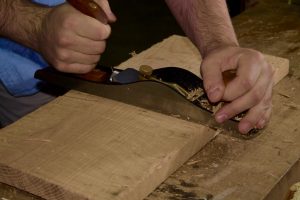
Photo: Avi Schwarzchild
The flattening begins with a jack plane with its blade set for an aggressive cut. Working perpendicular to the grain, the major peaks and valleys are removed. This produces coarse, splintery shavings.
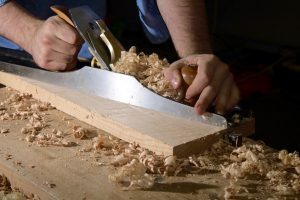
Photo: Avi Schwarzchild
Next, a jointer plane is used (above) with its blade set more conservatively. Its long body ensures uniform flatness over the entire surface as the plane is moved parallel to the grain. Note the wispy, fluffy shavings. An 18th century menuisier flattens a board with a jointer plane (below).
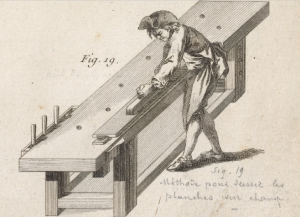
“Plate 14. Outils propres au corroyage du bois et la maniere de s’en servir.” from L’Art du Menuiserie, wtr. Roubo, André Jacob engr. Laurent, Pierre. New York Public Library Digital Collections. Accessed December 13, 2016.
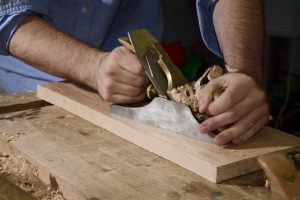
Photo: Avi Schwarzchild
Finally, a smoothing plane is used parallel to the grain (above). Taking the thinnest shavings, it removes any marks left behind from the previous two planes and ensures a glassy, smooth surface.

Photo: Avi Schwarzchild
The milled board on left compared with its original, rough-sawn state on the right. The planing process is repeated on all sides and done carefully to ensure squareness and uniform thickness.
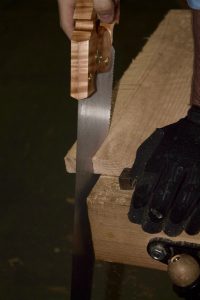
Photo: Avi Schwarzchild
Once the board is milled, each piece must be dimensioned. This is achieved using a panel saw that cuts along the grain.
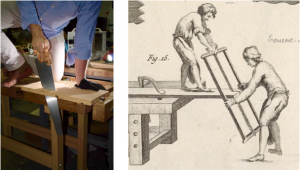
Left Photo: Avi Schwarzchild. Right Photo: “Plate 12. Outils, propres a refendre et a débiter, le bois.” from L’Art du Menuiserie, wtr. Roubo, André Jacob engr. Milsan. New York Public Library Digital Collections. Accessed December 13, 2016.
To efficiently saw down a board’s length, the longer the saw the better. Gravity is an important aid. Demonstrated in both pictures, a near vertical angle is best for this type of sawing.
Next: Cutting the Joinery